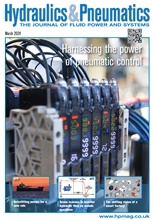Virtual operator training offers learning without limitations

By Matthew Masarik, marketing manager, design software, Rockwell Automation.
Giving operators the robust training they need to do their jobs effectively can be difficult today for many reasons. Perhaps chief among them are production pressures. Often, you can’t afford to keep production down long enough to give operators the training they need. Also, manually loading and cycling machines for training purposes can be an onerous process, which can limit training quantity and quality, because you can only physically recreate so many production scenarios.
Still, amid these challenges, operator training has perhaps never been needed more than it is today. A major demographic shift is underway in the industrial workforce. And if you want to protect your current productivity, quality and safety performance levels, it’s vital that you give new, less experienced operators the competencies they need and pass on historical knowledge from seasoned workers.
This is why it may be time to rethink how you provide operator training. Specifically, by adopting virtual training, you can develop competent, knowledgeable operators while avoiding the disruptions and costs that come with traditional training.
Training free from disruptions
Virtual training uses a digital twin, or digital replica, of your physical production assets to create a virtual training environment. There’s no need to stop a physical machine or wait for a new machine to arrive to train operators. Instead, you can digitally recreate the machine to a high level of detail. And you can apply physics to the machine to mimic how it moves and interacts with people and other machines.
Operators can then access the digital twin on a device screen or by using a VR headset to train in a safe, immersive training environment. Putting operators inside a dynamic digital twin model means they don’t need a physical machine to train, nor do they need to be in the same location as the machine. Consider the flexibility of training on a machine model anywhere in the world.
You can give operators the level of training they need, when and where they need it, while production continues uninterrupted. And that’s just the start, because virtual training allows you to do so much more.
More flexible training
There are only so many production scenarios that you can replicate in physical training. Because of this, workers may not be prepared for certain situations when something goes wrong. With virtual operator training, workers can learn to keep production running in ideal operations and learn how to respond to exceptional situations.
For example, you can inject simulated faults and extreme conditions into the training process. Then, after an operator completes the scenario, you can give them feedback to help them understand if they responded appropriately. If needed, you can also run the scenario again to help them improve their response.
This can better prepare operators to respond to similar incidents in a live production environment and potentially reduce downtime or scrap. No matter what scenario you put operators through or how they respond – you can always take comfort knowing that you can reset everything with the push of a button.
Improve competency
Virtual training can help operators learn their jobs in new and more effective ways. Digital cues, for example, can help guide workers during training. If a worker is being trained on an assembly task, digital cues like moving arrows can help them identify the specific part they need to pick up, and a glowing or highlighted assembly fixture can help them identify where they need to place the parts.
Then, you can remove the digital cues to see if the operator can complete the risk without them. Workers can also be free to make mistakes in virtual training without worrying about disrupting production. If an operator does something wrong, that action can be recorded for remediation purposes. And operators can be required to demonstrate their competency in training before they’re put into the pressures of live production.
Benefits beyond training Virtual training can help workers build their skills and competency in a safe, immersive environment where mistakes have no real-world consequences. But the training can also help your business in other ways. You can observe operators or get feedback from them about tasks, for example, to identify ways to make those tasks more efficient. And you can train and test operators in the virtual world to see if calculations like throughput rate estimations are realistic.
https://www.linkedin.com/company/rockwell-automation/
https://twitter.com/ROKAutomationUK
-
Smart Manufacturing & Engineering Week
05 - 06 June, 2024
NEC, Birmingham -
HILLHEAD 2024
25 June, 2024, 9:00 - 27 June, 2024, 16:00
Hillhead Quarry, Buxton, Derbyshire UK










